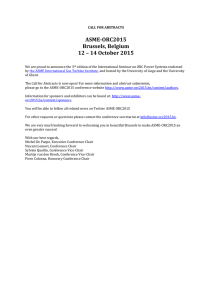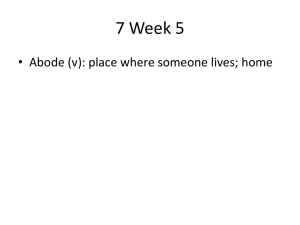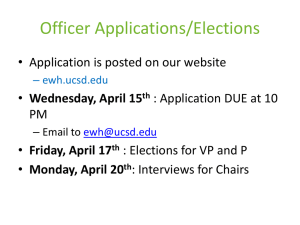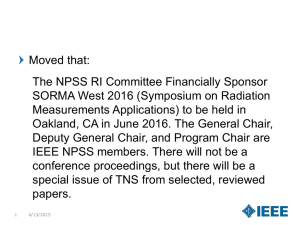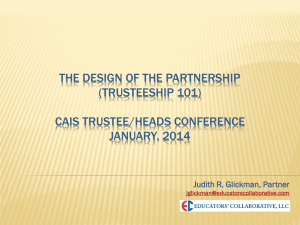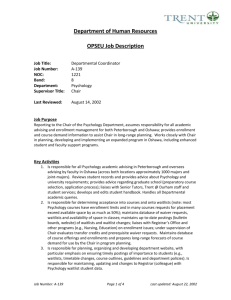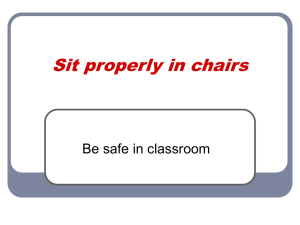Document
advertisement
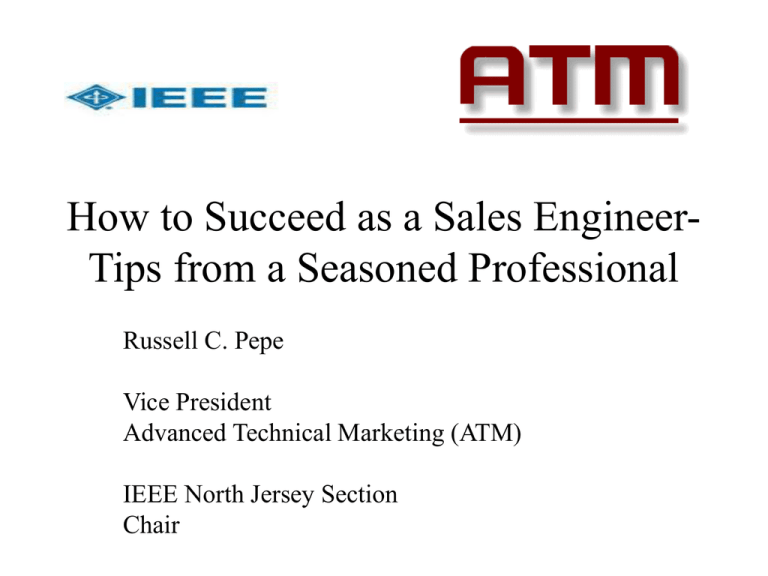
How to Succeed as a Sales EngineerTips from a Seasoned Professional Russell C. Pepe Vice President Advanced Technical Marketing (ATM) IEEE North Jersey Section Chair Agenda • • • • • • • • • • • • • • • • • • • Background Basics Psychology Activity Strategy Accounts Account Identification Contact Network Styles Coach Investigate Resources Tools Database Funnel Remember You Price and Competition Etc. Background Why should you be listening to the guy standing in front of the room? • • • • • • • BSEE (Communications Systems) and MSEE (Fiber Optics Systems) from NJIT IEEE Member since 1973 – North Jersey Chair, Vice-Chair, Secretary, IMS Chair, SAC Chair, Industry Liaison, MTT Exhibitor Chair – 5-Years as an Applications Engineer-Sales Support More than 20-years Sales Experience – 4-Years with Anritsu-Direct Sales • Presidents Club 3 of 4 Years (Top Sales Engineer in Company) • Exceeded Quota every Year – 17-Years (12 Years as Owner) with ATM-Representative Sales Mentored by Agilent Sales Training Engineers Numerous Sales Training Seminars Numerous Sales Training Books Sales Experience with Test Equipment, Components and Engineering Services – Fiber Optics, RF/Microwave, EMC, General Purpose Basics • Confidence – Know your Products and Customers – Speak with Authority • Be Prepared – Elevator Speech – Review Cards • Comfortable – “Where else can I get paid to hang out with my friends?” Basics • Consultative – People Like to Buy, but do not Like to be Sold – Explain, Suggest • Honesty/Ethics – Know Your Boundaries – Feel Comfortable to Say “I do not know.” – Never Make it up • Stop Talking and Listen – You have 2 Ears and 1 Mouth Basics • Identify • Meet • Qualify – Technical Need – Funding • Present • Demonstrate • Quote • Follow Up • Close – Remember to Ask for the Order!!! Psychology • 4 Quadrants of Personality – Analytical – Sensitive – Driver – Emotional Psychology Driver Emotion Analytical Sensitive Emotional Drive Activity • 4 Visits per Day – Long Introductory Meetings – Short Follow-Up Meetings – Presentations – Demonstrations • 4 Days per Week • One Office Day Strategy • Area – Zip Code Range – County – Office Park • Accounts • Technology • Product Accounts • A Accounts – 3 to 6 Key Accounts – Account for 50% of Business – Visit Weekly to Monthly – Fully Understand Organization – Stay Abreast of Company News Accounts • B Accounts – Approximately 12 Major Accounts – Account for 30% of Business – Visit Monthly to Quarterly – Identify Major Departments, Personnel and Projects Accounts • C Accounts – Remaining Accounts in Territory – Account for 20% of Business – Make Contact Account Identification • Chain of Command – Key Technical Contact – Key Decision Maker – Key Purchasing Contact – Key Deal Breaker • Know Who Will Support or Obstruct You Contact • Try to Be Exposed to All Your Customers Once per Month • Visit – Lunch, Dinner, Entertainment • Call – Try Different Days, Times • E-Mail • Mail Network • • • • • • Family Friends Neighbors Community and Church Groups Your Children Professional Societies-IEEE – Meetings – Seminars – Conferences • Current Customers Styles • Be Yourself – Find What Works for You • Focus & Diversify – If It Works, Continue Doing It – Experiment with New Methods – When in a Slump, Rethink Your Methods Coach • • • • • Give and Take Favors Available for Visits in Emergency Information Try to Talk Away from Company Investigate • • • • • • • Web Find one Contact, then Network Identify Products, Programs and Projects Identify Departments Go into Lab Ask Who Else Never Assume Resources • • • • • • Applications Engineers Account Managers Management Seminars Lunch & Learn Learn from Customer Presentations Tools • • • • pc – Database – Office Smart Phone – Database – Contacts – Calendar – Text Tablet – I do not use-I still use paper – Data Sheets – Drop Box Car – Look successful, but not like a crook – Room for customers and equipment Database • Electronic Database – ACT – SalesForce • Contact Information • Organizational Information • Technology Information • Product Information • Notes Funnel (Forecast) • Keep Track of Projects and Quotes • Use for Follow Up • Typically 20% to 67% Close – I use 20% (To book $2M you need to forecast $10M) • Probability Percentages – – – – – 90%: 75%: 50%: 25%: 10%: Technically Approved, Funded and In Process Technically Approved and Funded Quoted and Likely to Occur Quoted, but Outcome Unknown Projected, but not Likely to Occur Soon • Fill the Funnel Remember You • Business Cards • Name Labels • Tokens – Magnetic Business Cards – Personalized Pens – Personalized Note Pads – Calendars • Visit, Call, E-Mail, Mail Price and Competition • • • • • • • • • • • Sell Features and Benefits (FAB) Use Fear and Doubt (FAD) Know Competitive Pricing Be Prepared Do not Engage in Negative Selling Understand the Application Highlight What you Offer Respective to the Requirement Do not Sell on Price Your Price is Based on Performance, Quality and Reliability Discount Now-Discount Forever Discount on Quantity – Blanket PO – Commitment Up-Front to Quantity – Extend Delivery Etc. • • • • • • Follow Service Issues Make Something Good of Something Bad Capitalize on Success Learn from Mistakes Carry Forecast Follow Up Reminders in Database


